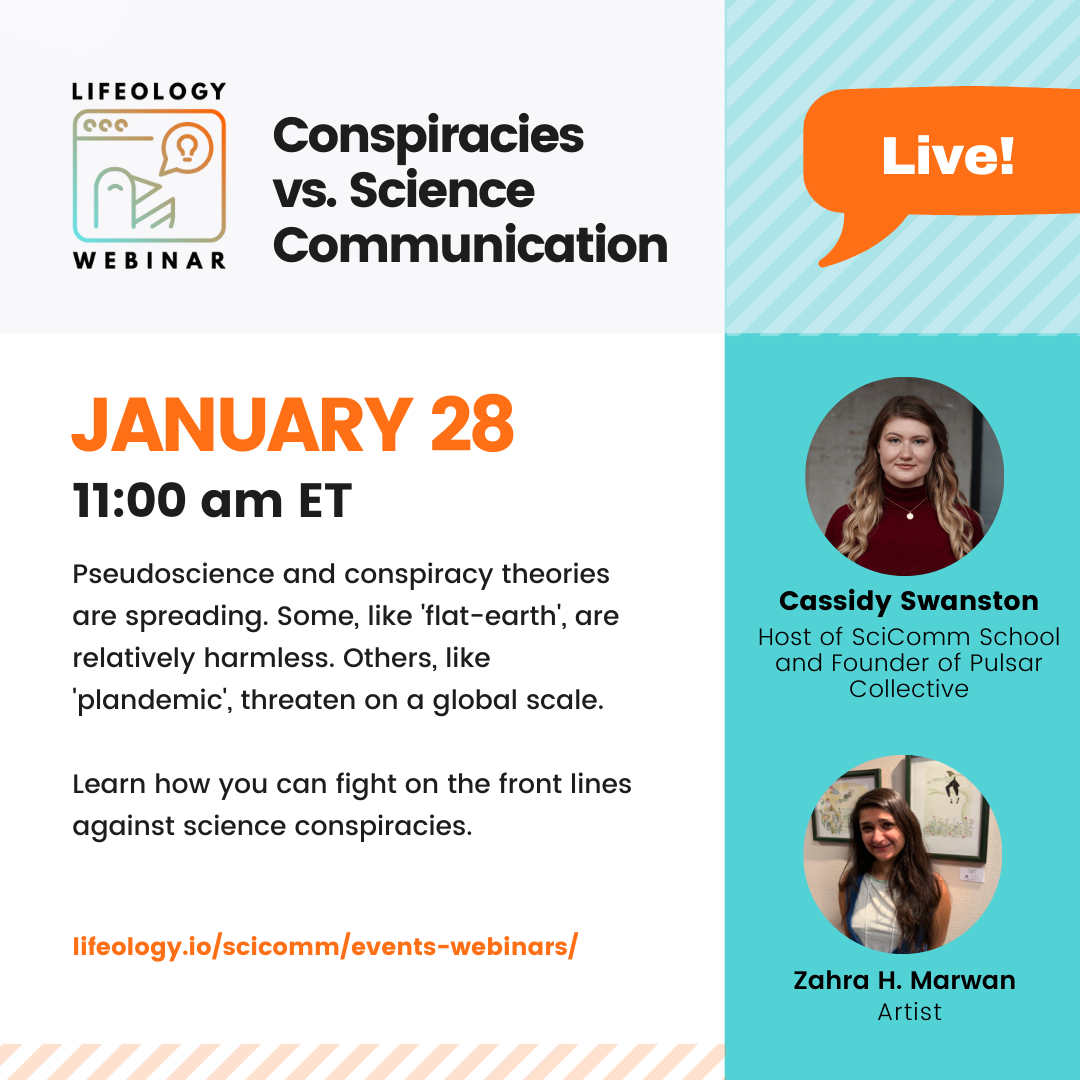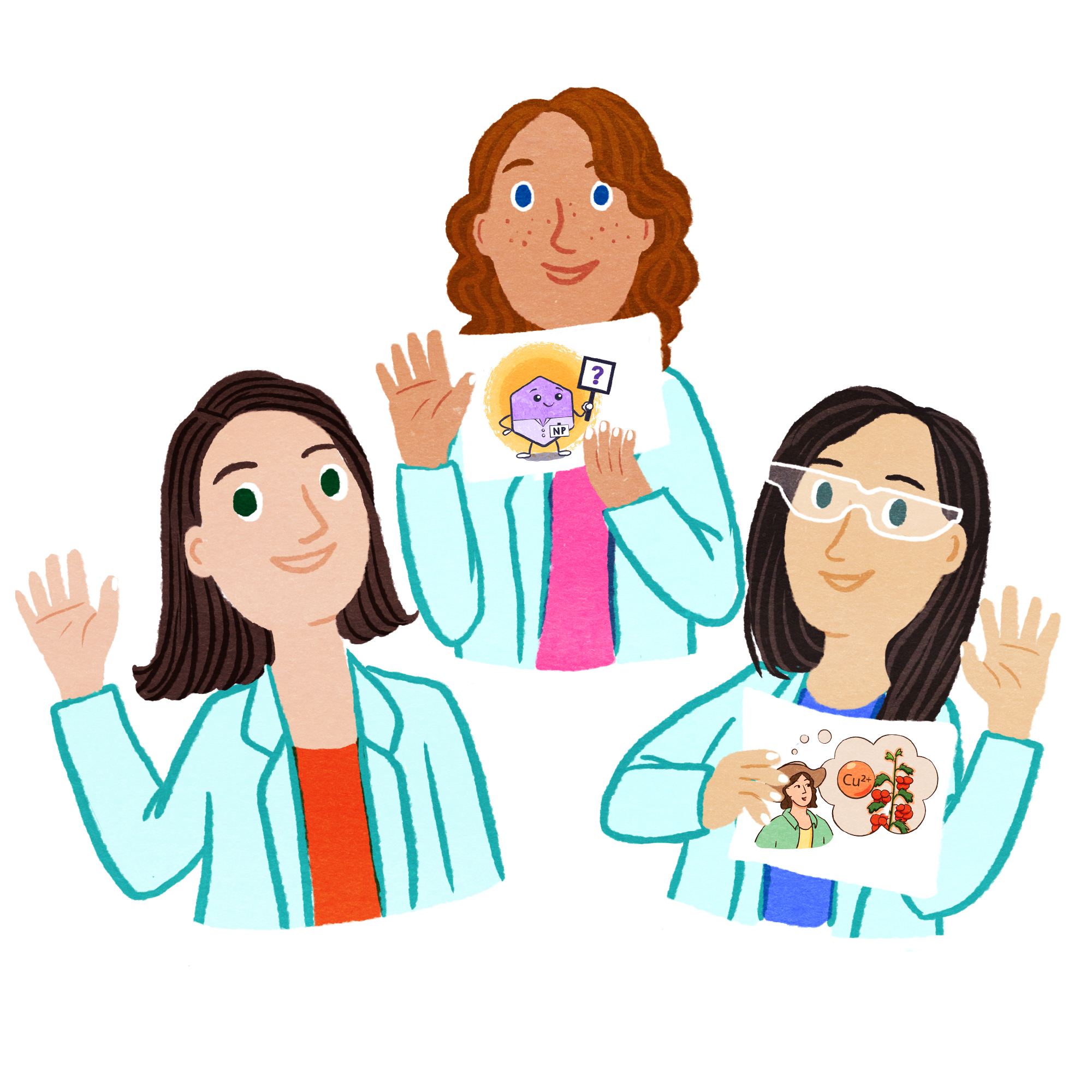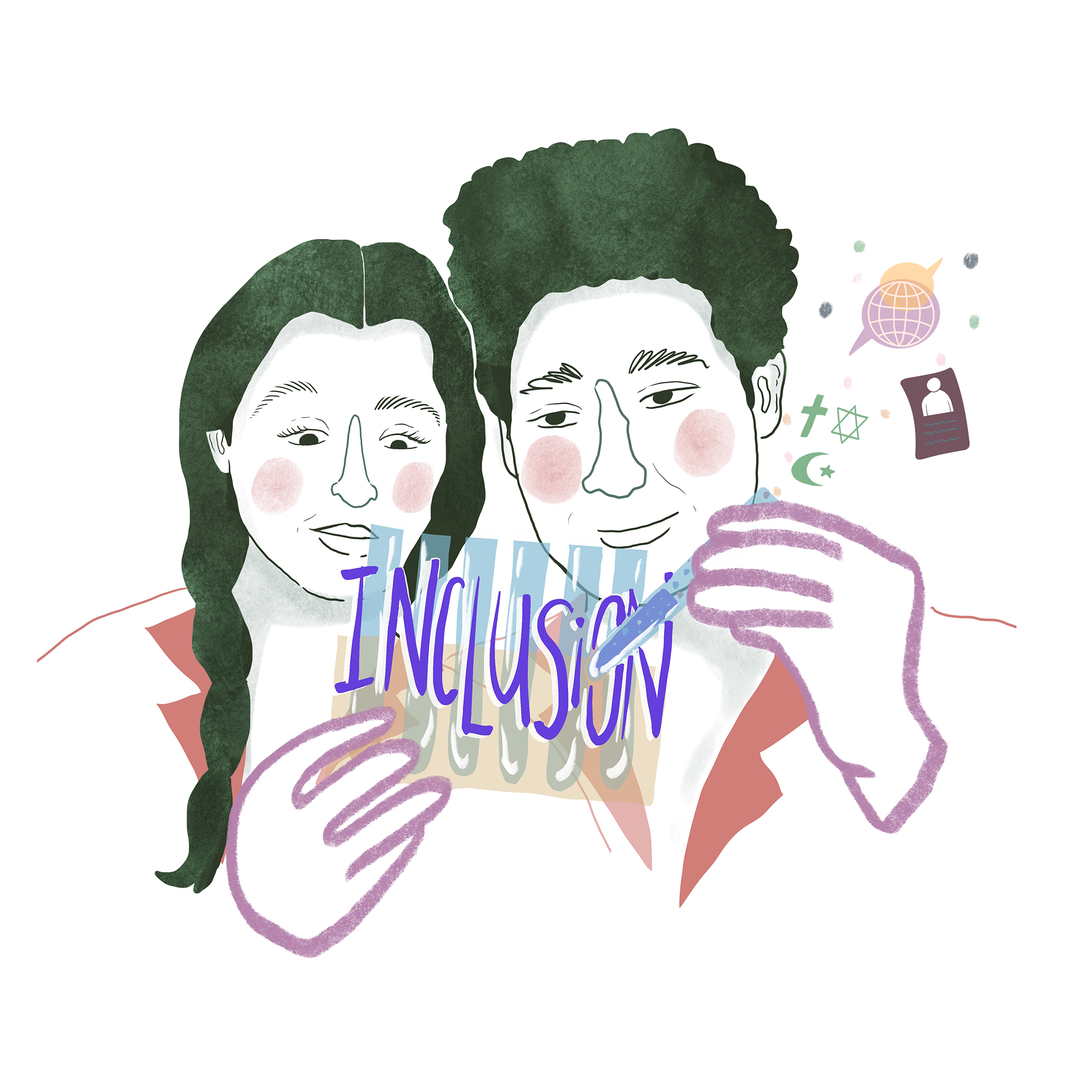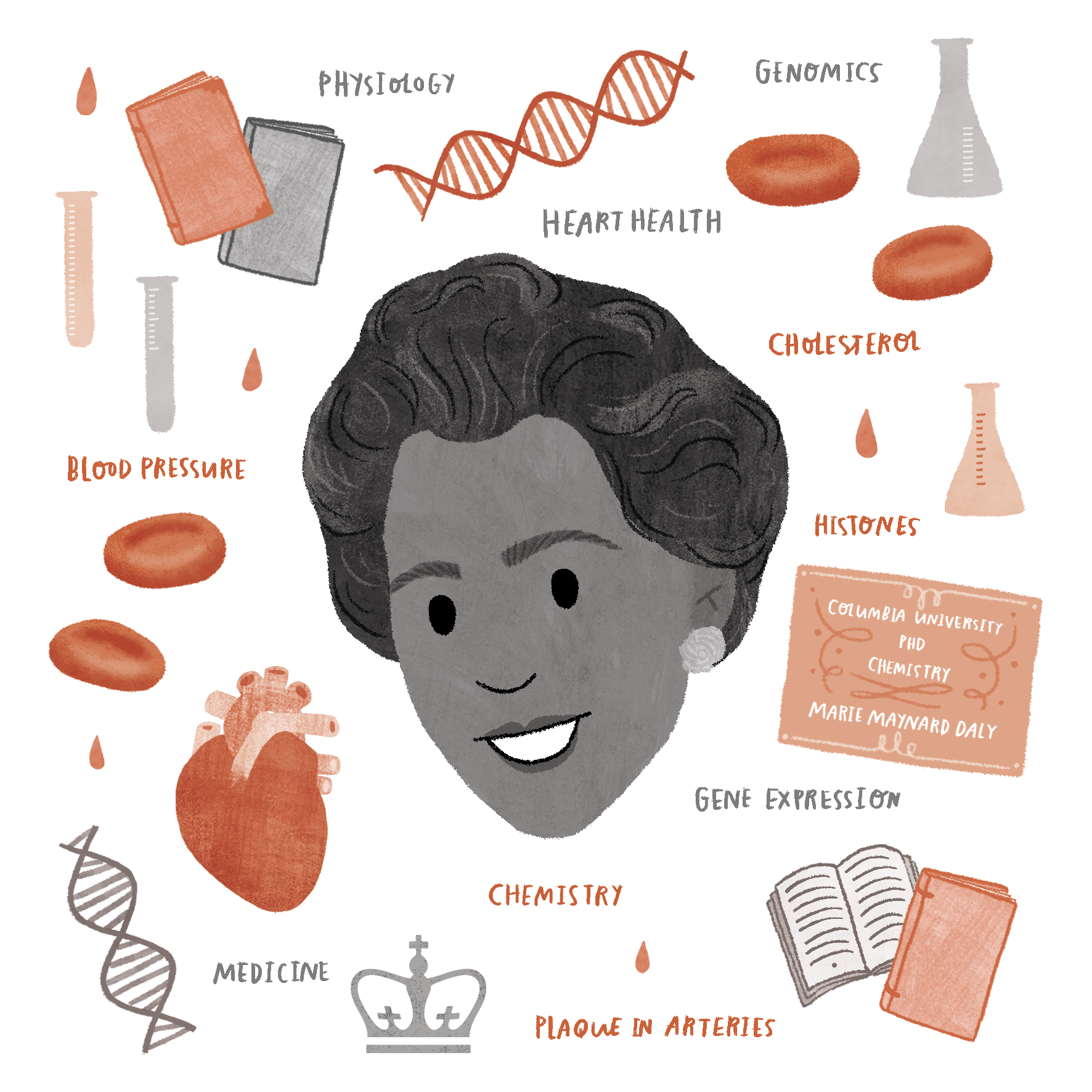What kind of collaborator are you? Let’s get to finding out! Check out the full video and a recap of Lifeology’s webinar “Getting to Know Yourself as a Collaborator” below.
An illustration of our webinar presenters by Alberta Torres from our “How to Write About Science Collaboratively” course.
On December 7, Jaya Borgatta, Paige Kinsley and Stephanie Mitchell, a group of chemistry graduate students hosted Lifeology’s fourth live webinar! Our new webinar series brings our community topics related to SciComm and SciArt in a workshop setting, often supplementing our Lifeology SciComm University program courses.
Jaya, Paige Kinsley and Stephanie are colleagues at The NSF Center for Sustainable Nanotechnology who have written two (now three!) Lifeology courses together. We worked with them to create two Lifeology courses about how nanotechnology can be applied responsibly to solve real-world problems like growing more plant food and how we can all be better stewards of the nanoparticles that exist in the devices that power our lives. Their third and most recent course was about their process of collaborating on the previous courses!
“How to Write About Science Collaboratively” brings you many of the lessons learned by Jaya, Paige K and Stephanie during the course creation process. This course, illustrated by Alberta Torres, likens writing collaboratively to the process of making a quilt. And now they have brought you a webinar about it, too! Spoiler alert: it’s a great one!
We’ve attached the full video of the webinar below for your viewing and you can find the slides from their presentation here. You can also find a recap, including some main takeaways.
The webinar was incredibly interactive and Jaya, Paige K. and Stephanie did a phenomenal job of using different methods of engagement. We have included some highlights here in this post, but watch the full webinar to experience it for yourself, including reflecting on your own behaviors as a collaborator on projects.
After an introduction to The NSF Center for Sustainable Nanotechnology and of the presenters and the goals of both parties during the Lifeology courses, the presenters polled the audience with “What is the value of collaboration?” Participants gave free responses to this question, and a few of the answers are summarized in the visual and list below:
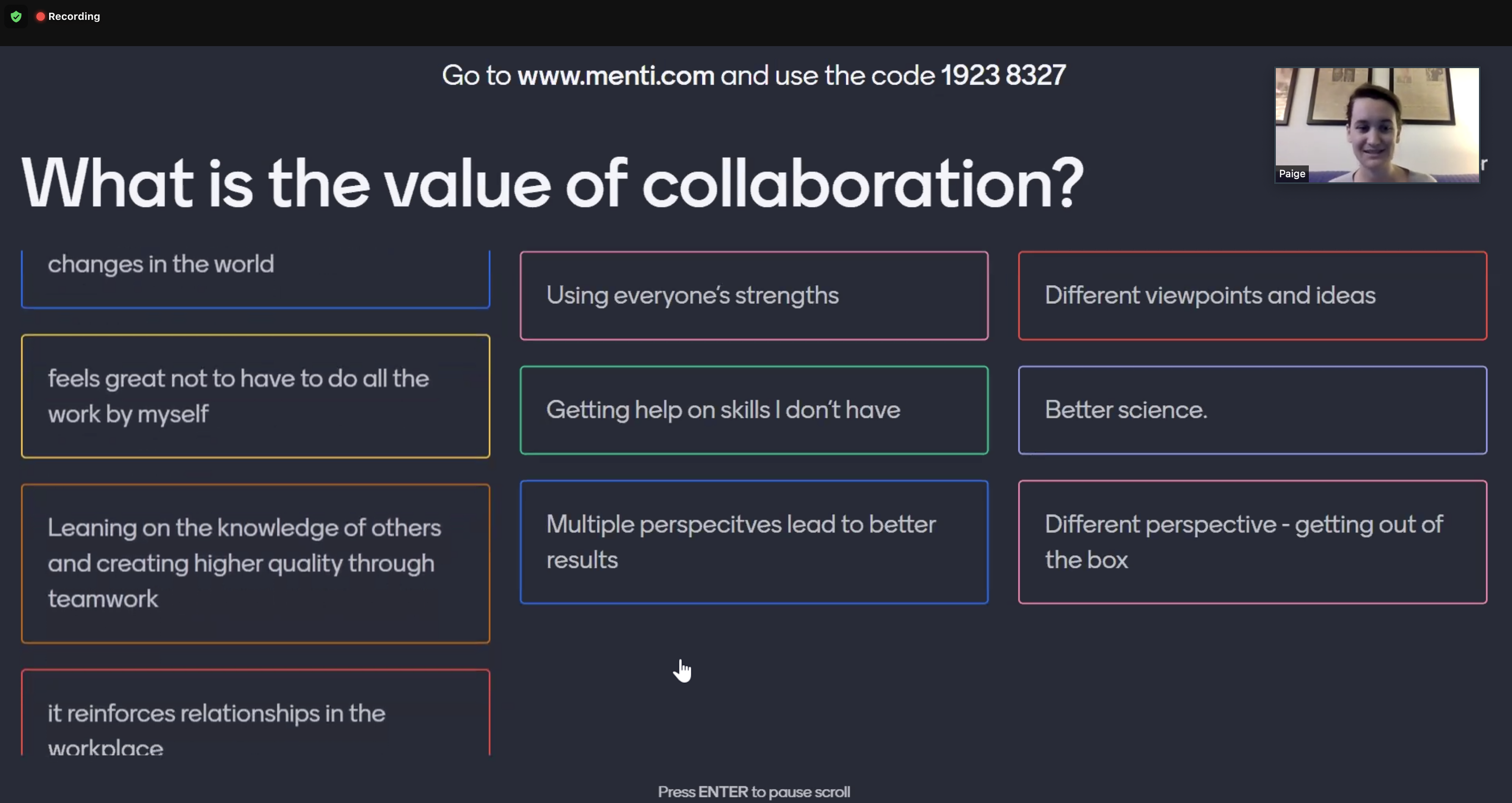
Answers to “What is the value of collaboration?” in the image above:
- Feels great not to have to do all the work by myself
- Leaning on the knowledge of others and creating higher quality through teamwork
- It reinforces relationships in the workplace
- Using everyone’s strengths
- Getting help on skills I don’t have
- Multiple perspectives lead to better results
- Different viewpoints and ideas
- Better science
- Different perspective– getting out of the box
After the participants shared their ideas, the presenters gave some reasons that collaboration was valuable for the presenters in their three Lifeology courses.
- Different backgrounds, disciplines, skills, life experiences and culture
- Pushed them to think creatively
- Division of labor and increased efficiency
- Built lasting relationships
Next up was another poll. They asked, “What makes for a successful, healthy collaboration?” Participants also gave free responses to this question, and a few of the answers are summarized in the visual and list below:
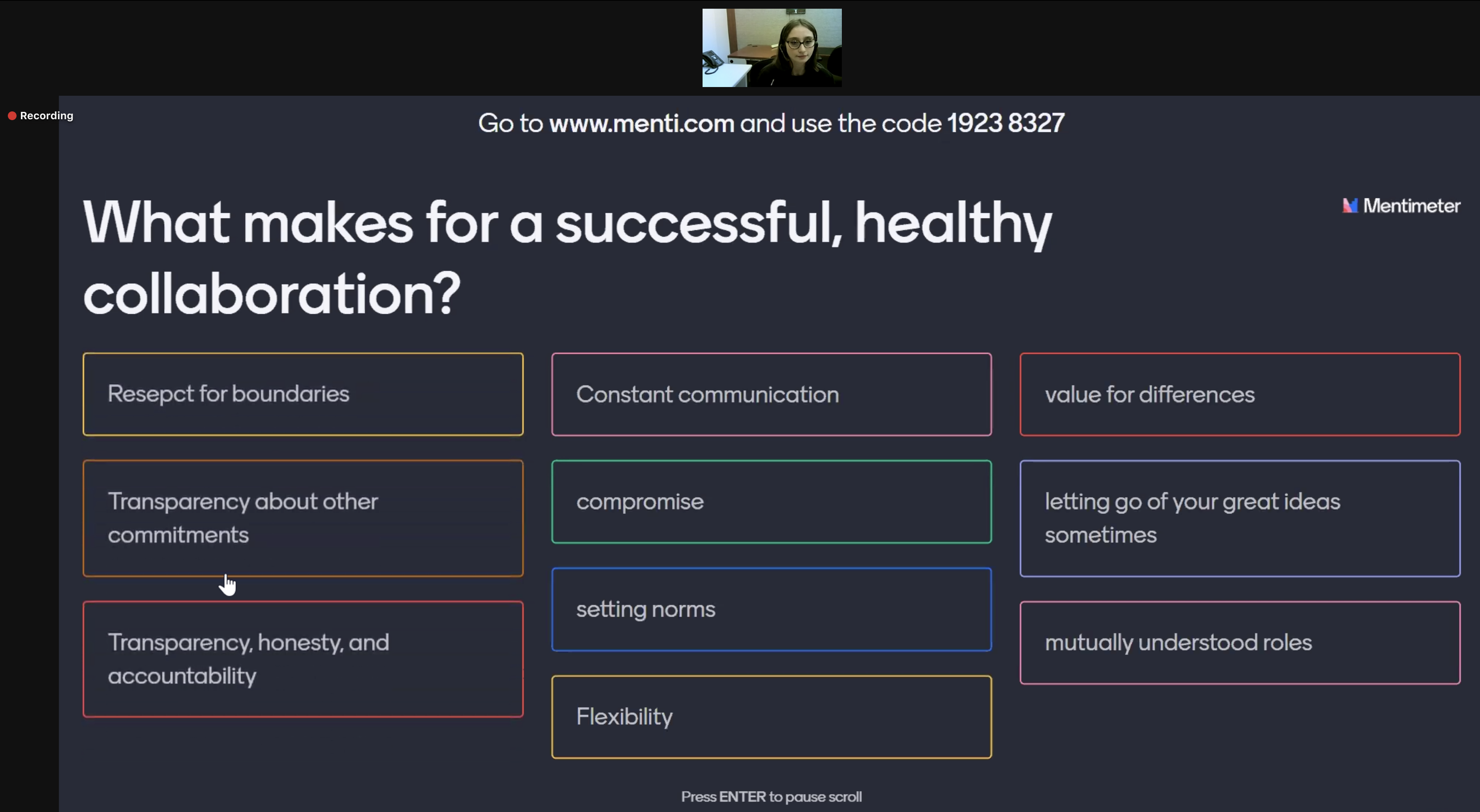
Answers to the “What makes for a successful, healthy collaboration?” in the image above:
- Respect for boundaries
- Transparency about other commitments
- Transparency, honesty, and accountability
- Constant communication
- Compromise
- Setting Norms
- Flexibility
- Value for differences
- Letting go of your great ideas sometimes
- Mutually understood roles
As you can see, the answers above have some commonalities. And that’s because effective teams don’t happen by accident. A process is in order. The presenters offered some stages of collaboration (forming, storming, norming, performing) based on what is in the literature and added their own additional step (celebrating) at the end.
First up is the forming stage. This involves building a positive and collaborative team. It is important to get to know each other. What strengths, weaknesses, and goals are within the team? How will you all handle conflict that will inevitably arise? At this stage, the team should agree on an overarching purpose or goal, too. Team size can make a difference here in the roles each team member takes on and what the collaboration can look like, so it’s important to figure it out together!
“The way that your collaboration interacts will change a lot depending on how big your group is and how you decide to structure your leadership, but it should all be done very intentionally so that you’re hearing everyone’s voice and everyone feels safe in the collaborative environment.” – Jaya
Next is the storming stage! In this stage, the group continues to clarify roles and goals while implementing strategies and working on the project. This can be a fragile time where conflict can arise, so it is important to create a safe place (based on trust) for ideas from all team members. Because conflict will inevitably arise, it’s a good time to practice conflict management. Take it as an opportunity for innovation and harmonizing among the group.
One suggestion the panelists had to help with conflict (and the collaboration overall) was to establish a “gift culture” early on. This means being generous with your time and not looking at everything as a transaction. In other words, do things without expecting anything in return. This can help establish trust and maintain harmony in the group.
Another strategy, which is also discussed in the “How to Write About Science Collaboratively” course, is “Yes, And…” statements. These statements can be used for more efficient and effective dialogue. You acknowledge what the other person says before building upon that. This is better than “Yes, but…” statements that can make someone feel they were not listened to at all. These statements are great for the brainstorming stages (think: forming and storming) to keep things positive and collaborative.
After forming and storming, the next stage of collaboration is norming. This is the stage where the group finally feels in unity and everyone is respectful of each other’s strengths. How can you reach norming in a collaboration? Here are some tips from the presenters:
- Everyone respects each other’s perspectives and feelings.
- Begin and end the meetings on time and be present during those.
- Reflect on progress regularly.
- Publicly support your group.
- Directly confront conflict.
And finally, the performing (and celebrating!) stage. This time is when your team is performing to their fullest potential and supporting the mission of the project. Your team should also take the time to cherish the outcome of the project and be proud of it!
Then, both the audience and the panelists reflected on their constructive and destructive behaviors while in collaborative environments. Learn more about these behaviors and reflect on your own here.
“Different people will bring different challenges to a group and understanding those challenges and how to work with them is really important.” -Jaya
Once you’ve identified your own constructive and destructive behaviors, consider these questions:
- What effect do you think they have had on collaborations?
- How will knowing these behaviors change how you collaborate/approach group interactions in the future? How do they affect how you respond to conflict?
- Are there any surprises, insights, or revelations about your behaviors? What do you want to do about that moving forward in future collaborations?
Some awesome conversations happened during the webinar based on these questions. Both the audience and the presenters were vulnerable with their responses, and I encourage you to watch just the last ~30 minutes of the webinar if you are tight on time. We will also be sharing some soundbites of the webinar over on our social media in the coming weeks.
Missed last month’s webinar? Check out January’s webinar about communicating about conspiracy theories–happening January 28, 2022, at 11 am ET. Register now and see you there!
